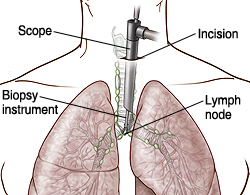Surgical Diagnosis of Chest, Lung Problems
Surgical Diagnosis of Chest, Lung Problems
You’ve been told you need a surgical procedure to diagnose a problem in your chest or lung. Surgical procedures are used to get large samples of tissue or lymph nodes from the chest or lung. These samples allow for more complete testing. Surgical procedures typically require incisions and may take some time to recover from.
|
Mediastinoscopy
Mediastinoscopy allows the doctor to see inside the area between the two lungs (mediastinum) and remove large lymph node samples (biopsy). First, an incision is made at the base of the neck. A scope is passed through the incision down into the mediastinum. Then a biopsy instrument is passed through the center of the scope. Once the lymph node sample is taken, the instrument is pulled up through the scope. The sample is then tested for cancer or other problems.
Video-assisted thoracic surgery
Video-assisted thoracic surgery (VATS) allows the doctor to see inside the chest and take tissue samples. VATS is done using an instrument with a light, lens, and camera (thoroscope). First, an incision is made on the side of the chest. The scope is passed through the incision into the space between the lungs and chest wall (pleural space). Images of inside the chest are sent to a monitor viewed by the doctor. Other small incisions are made for instruments to pass through and remove tissue. VATS can also help diagnose and stage cancer.
Thoracotomy
In certain cases, open surgery is needed to diagnose and treat a lung or chest problem. If so, incisions are made and the chest is opened. This allows the doctor to see inside the chest and take a sample of lung tissue or a mass.
Preparing for the procedure
Before your procedure, do the following:
Follow your doctor’s instructions about eating and drinking.
Tell your doctor about the medicines and herbal supplements you take. You may need to stop taking certain medicines before the procedure, especially aspirin, warfarin, or other blood thinners.
Discuss any allergies and health problems with your doctor.
Tell your doctor if you are or could be pregnant.
During the procedure
You receive general anesthesia (medicine to make you sleep) during the procedure. Once you are asleep, incisions are made in the neck, chest, side, or back to allow the doctor to view the area or take a biopsy if needed. A tube placed in the chest during surgery drains fluid.
Risks and complications
Hoarseness
Bleeding
Infection
Abnormal heart rate
Collapsed lung
Injury to other structures in the chest
Respiratory failure (rare)
Nerve damage
Death (rare)
Updated:
March 20, 2017
Reviewed By:
Blaivas, Allen, J., DO,Image reviewed by StayWell medical illustration team.,Sather, Rita, RN

